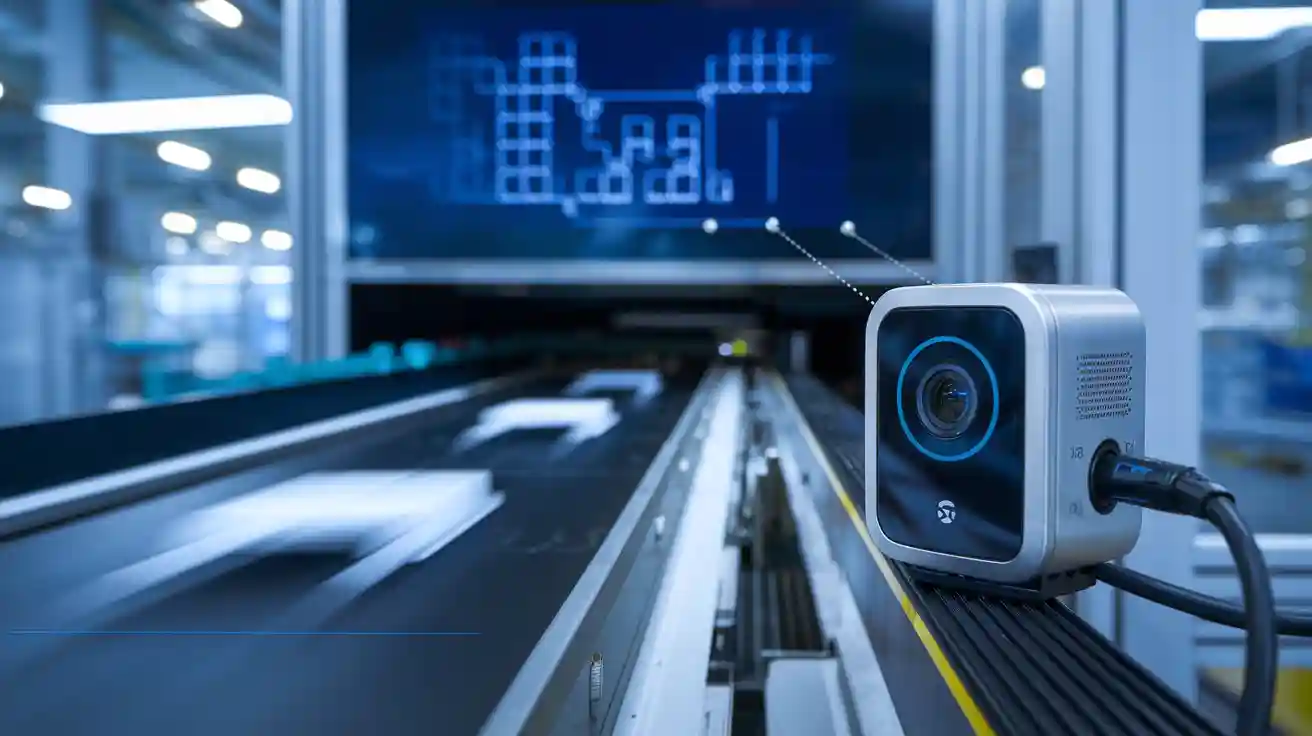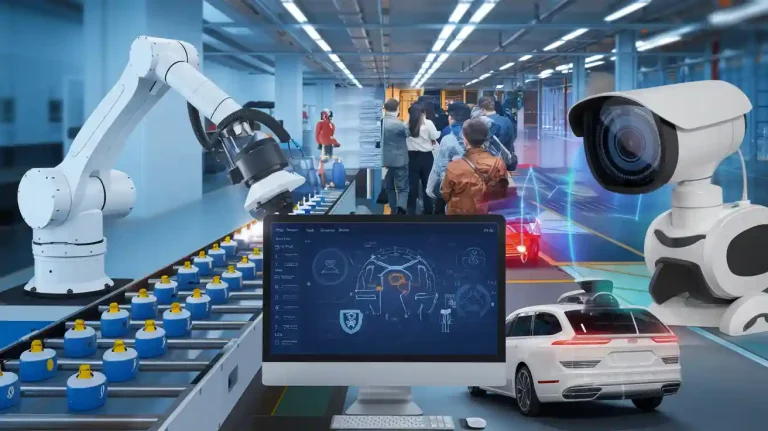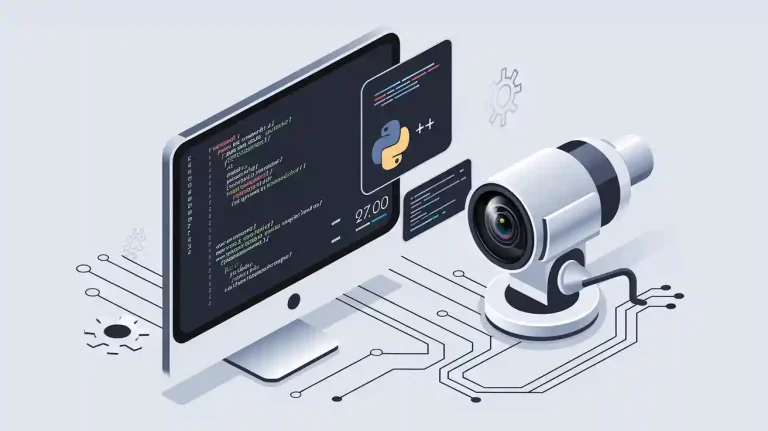
Edge devices in machine vision systems serve as specialized hardware that processes visual data directly at the source. These edge units operate within iot environments, handling images and video streams in real-time. Unlike cloud-based solutions, edge processing allows devices to analyze information instantly, which makes them essential for iot applications that require immediate feedback. The Edge Devices machine vision system reduces bandwidth needs and improves privacy by keeping sensitive data on-site. Real-time analysis ensures that iot systems can respond quickly to changes, which is vital for safety and efficiency. By performing real-time tasks locally, iot edge devices offer greater security and lower operational costs.
Key Takeaways
- Edge devices process visual data locally, enabling fast, real-time analysis with low latency and improved privacy.
- These devices use specialized hardware like GPUs and AI models to perform tasks such as object detection and image classification on-site.
- Edge machine vision systems reduce bandwidth use and operational costs by limiting data sent to the cloud.
- Applications include industrial automation, smart cities, healthcare, and retail, where instant decision-making improves safety and efficiency.
- Deploying edge AI requires careful model optimization, security measures, and system integration to ensure reliable and scalable performance.
Edge Devices Machine Vision System
What Are Edge Devices?
Edge devices in a machine vision system act as the physical hardware that performs local data processing. These devices sit close to the source of visual data, such as cameras or sensors, and handle tasks that would otherwise require remote servers. Edge computing allows these devices to analyze images and video streams on-site, reducing the need to send large amounts of data to the cloud. This approach leads to faster response times and improved privacy.
Edge devices in machine vision differ from traditional computing devices in several ways. They are purpose-built for industrial environments, often featuring rugged designs that withstand temperature extremes, shocks, and vibrations. These devices use specialized hardware, including multi-core CPUs, GPUs, VPUs, and FPGAs, to accelerate real-time AI inference and image analysis. Many edge devices also offer flexible I/O options, supporting multiple cameras and sensors for seamless integration.
Edge computing in machine vision enables immediate decision-making, which is essential for applications like defect detection on production lines or real-time monitoring in smart cities.
Popular edge devices in this field include platforms like NVIDIA Jetson, Raspberry Pi, and Google Coral Dev Board. NVIDIA Jetson models, such as the Xavier NX, provide high AI performance and GPU acceleration in a compact, energy-efficient package. Raspberry Pi 4 offers versatility and affordability, making it suitable for a wide range of edge-based computing solutions. These platforms support advanced machine vision technology by delivering the necessary computing power at the edge.
A comparison of edge devices and traditional computing devices highlights their unique strengths:
| Aspect | Edge Devices in Machine Vision Systems | Traditional Computing Devices |
|---|---|---|
| Data Processing Location | Local processing at or near data source to reduce latency and bandwidth | Centralized processing in cloud or data centers |
| Architecture | Decentralized, combining hardware, software, and networking at edge | Centralized, relying on remote servers |
| Hardware | Specialized CPUs, GPUs, TPUs, accelerators; ruggedized for industrial use | General-purpose CPUs, less ruggedized |
| Functionality | Real-time data filtering, AI inference, and analytics on-site | Data sent to cloud for processing and storage |
| Latency | Low latency enabling immediate decision-making | Higher latency due to data transmission delays |
| Bandwidth Usage | Reduced by filtering and transmitting only relevant data | High bandwidth usage due to constant data transmission |
| Security | Enhanced by limiting data transmission and local processing | Potentially less secure due to data transmission |
| Use Case in Machine Vision | Handles high-speed camera data and AI inference for defect detection | Limited real-time capability due to latency and bandwidth constraints |
Components of a Machine Vision System
A complete edge devices machine vision system includes several key components. Each part plays a vital role in ensuring accurate and efficient operation.
- Edge Device: The core of the system, responsible for local data processing and running AI models. Devices like NVIDIA Jetson and Raspberry Pi 4 are common choices.
- Camera: Captures high-resolution images or video streams. Cameras often use CCD or CMOS sensors, with global shutters preferred for capturing fast-moving objects without distortion.
- Illumination: Provides consistent lighting to reduce shadows and highlights, ensuring clear image capture for analysis.
- Power Supply: Delivers stable power to all devices, supporting reliable operation in industrial settings.
- Peripherals and Hardware Interfaces: Includes I/O ports such as USB, LAN, and GPIO for connecting cameras, sensors, and other devices. Wireless options like WiFi, 3G/4G/5G, and Bluetooth support mobile and future-proof applications.
- Firmware and Image Processing Software: Runs on the edge device, analyzing captured images for pattern recognition, measurement, and defect detection. AI and machine learning algorithms enhance accuracy and speed.
- Calibration Tools: Align and adjust system components to maintain precision and reliability.
- Protective Covers: Shield devices from dust, water, and industrial hazards. Many covers have IP67 ratings for durability.
Tip: Integration and system design ensure all components work together smoothly, optimizing the performance of the edge devices machine vision system.
The hardware inside edge devices often includes multi-core CPUs for multitasking, GPUs for parallel processing, VPUs for efficient vision tasks, and FPGAs for custom workloads. Some devices use NVMe computational storage to process data directly on the drive, reducing latency. These features make edge computing ideal for real-time machine vision applications.
A few examples of edge device models and their features:
| Edge Device Model | Type | Key Hardware Features |
|---|---|---|
| TB-5545-MVS | Fanless Box PC | High performance, multiple expansion options |
| TB-5545-PCIe | Compact PCIe Embedded | High performance, compact form factor |
| TP-5045-15 | Fanless Panel PC | All-in-one panel PC, includes 2.5" SATA drive bay |
Edge computing in machine vision systems brings together these components to deliver fast, reliable, and secure image analysis at the source. This approach supports a wide range of applications, from industrial automation to smart city surveillance, by leveraging the strengths of edge-based computing solutions.
How Edge Devices Work
Data Capture and Processing
Edge computer vision systems begin with data capture. Cameras and sensors on iot devices collect visual information from the environment. These devices use optimized hardware, such as GPUs and TPUs, to process data streams efficiently. Edge ai machine vision systems rely on this hardware to balance power consumption and maintain high throughput. Adequate memory and scalable components ensure smooth management of continuous data streams.
Edge computing enables iot devices to process visual data locally. This approach avoids cloud dependency and supports real-time machine vision tasks. Edge-based machine vision systems use computer vision techniques like object detection, image classification, feature extraction, and anomaly detection. Object detection identifies and locates objects in images or video streams instantly. Image classification sorts images into categories in real time. Feature extraction reduces data dimensionality by highlighting important visual features. Anomaly detection flags unusual patterns or events without delay.
Edge ai machine vision systems achieve impressive processing speeds. For example, devices using Ampere processors with native FP16 support can process up to 60 frames per second. Latency remains low, often at the millisecond level, even on low-bandwidth connections. Lightweight AI models and optimized data pipelines help reduce data transmission by up to 75%. This efficiency allows iot devices to deliver real-time decision-making in dynamic environments like industrial automation and smart traffic management.
Note: Edge computing in iot environments ensures that sensitive data stays on-site, improving privacy and security while reducing bandwidth needs.
Edge computer vision systems use a variety of hardware types. CPUs, GPUs, NPUs, and Edge TPUs all contribute to high performance. These devices support real-time machine vision by enabling immediate responses to changes in the environment. Edge ai machine vision systems also use quantized models and hardware accelerators to reduce computational load and improve power efficiency.
Local Analysis and Decision-Making
Edge ai machine vision systems excel at local analysis and decision-making. These systems use advanced computer vision techniques to interpret visual data directly on iot devices. Machine learning and deep learning models, such as YOLO for object detection, run efficiently on edge hardware. These models support real-time decision-making by analyzing patterns, recognizing objects, and detecting anomalies without cloud delays.
The following table shows how different edge devices perform in key areas of real-time machine vision:
| Performance Aspect | TPU Devices | Raspberry Pi4 | Google Coral | Nvidia Jetson Nano |
|---|---|---|---|---|
| Inference/Execution Time | Supported | Supported | Supported | Supported |
| Energy Consumption | Supported | Supported | Supported | Supported |
| RAM Memory Consumption | Supported | Supported | Supported | Not Supported |
| Tested with Different Models | Supported | Supported | Supported | Supported |
| YOLO Benchmark Performance | Supported | Supported | Not Supported | Supported |
| Deep Learning Models Benchmark | Not Supported | Not Supported | Not Supported | Supported |
| Latency, Memory, Power Usage | Supported | Not Supported | Not Supported | Supported |
Edge ai machine vision systems use model optimization techniques like pruning and quantization. These methods allow models to run efficiently on resource-constrained devices while maintaining high accuracy. Real-time machine vision tasks, such as safety risk detection and robotic control, require decisions in under 100 milliseconds. Edge-based machine vision systems deliver this speed, making them ideal for time-critical applications.
Edge computer vision systems support a wide range of computer vision techniques. Object detection, image classification, feature extraction, and anomaly detection all play vital roles. These techniques enable iot devices to perform image-based analysis, recognize faces, inspect product quality, and monitor environments. Real-time decision-making ensures that iot devices respond instantly to changes, improving safety and efficiency.
Edge ai machine vision systems often match the accuracy of cloud-based analysis for immediate tasks. Properly optimized edge models can achieve accuracy comparable to expert human performance. Hybrid approaches combine edge ai for real-time decision-making with cloud ai for deeper analysis. This balance supports both speed and accuracy in edge computer vision applications.
Tip: Edge ai machine vision systems provide real-time, accurate, and secure decision-making for iot devices in industries such as healthcare, manufacturing, and smart cities.
Edge computing continues to evolve, supporting more complex computer vision techniques and larger networks of iot devices. As edge ai machine vision systems advance, they will enable even faster, more reliable, and more secure real-time machine vision solutions.
Edge AI Machine Vision Systems
Edge Learning and AI Models
Edge ai machine vision systems use advanced AI models to analyze visual data directly on iot devices. These systems rely on edge computing to process tasks like image classification, object detection, and anomaly detection without sending data to the cloud. Lightweight convolutional neural networks, such as YOLOv5, are popular for edge computer vision because they balance speed and accuracy. These models run efficiently on specialized hardware like NVIDIA Jetson, which supports a range of performance needs for edge ai machine vision systems.
Edge computing hardware must meet strict requirements for real-time machine vision. Devices need high-performance CPUs and GPUs to handle complex algorithms and fast image classification. High-bandwidth memory supports data-intensive workloads, while diverse I/O options connect multiple cameras and sensors. Rugged designs protect edge ai machine vision systems in industrial environments. Microcontrollers, microprocessors, and single-board computers all play roles in edge ai machine vision systems, depending on the complexity of the task.
Edge ai machine vision systems use optimized data pipelines and downscaling techniques to enable real-time inference, even when bandwidth is limited. Tools like TensorRT and DeepStream help optimize AI model performance and reduce latency on edge hardware.
Real-Time Processing
Edge ai machine vision systems deliver real-time results by processing data locally. This approach reduces latency and improves privacy, as sensitive information stays on-site. Edge computing enables iot devices to achieve processing speeds of 1 to 5 milliseconds, compared to 100 to 500 milliseconds for cloud-based solutions. This 95% to 99% reduction in latency makes edge ai machine vision systems ideal for real-time machine vision applications, such as autonomous vehicles and industrial automation.
Edge deployment frameworks support scalability and management for edge ai machine vision systems. Modular platforms like the Reusable Camera Framework allow flexible, multi-camera solutions. These frameworks provide APIs for real-time control, over-the-air updates, and integration with custom services. Unified management platforms enable centralized monitoring and policy enforcement across fleets of edge ai machine vision systems. Privacy-preserving architectures keep data local, reducing compliance risks and supporting secure edge computer vision.
- Key features of edge deployment frameworks:
- Hardware-agnostic and modular design
- Real-time control and post-processing APIs
- Over-the-air upgrades and configuration management
- Continuous learning and network-efficient training
- Centralized monitoring and robust security
Edge ai machine vision systems combine edge computing, real-time processing, and scalable frameworks to deliver fast, secure, and reliable image classification and analysis for iot environments.
Applications of Edge Computer Vision

Industrial Automation
Industrial automation relies on edge computer vision to transform how iot devices perform detection and analysis. These systems use smart cameras and sensors to monitor production lines, inspect products, and ensure safety. Construction sites deploy iot devices for hazard detection and compliance monitoring. Energy companies use edge computer vision for inspecting power lines and pipelines, preventing failures before they occur. Traffic systems benefit from real-time object detection, counting vehicles, and identifying accidents to improve flow.
Manufacturers invest in edge computer vision to reduce downtime and improve efficiency. North America and Europe lead adoption, while Asia-Pacific grows rapidly due to industrialization. The global edge market in industrial automation is expanding, driven by the need for real-time detection, security, and cost savings. Companies use drones for navigation and obstacle avoidance, robotics for object recognition and manipulation, and autonomous vehicles for immediate decision-making. These iot devices process data locally, reducing bandwidth and operational costs.
Real-time processing, bandwidth efficiency, enhanced privacy, scalability, and improved reliability make edge computer vision essential for industrial image analysis.
| Industrial Automation Applications | Benefits Provided |
|---|---|
| Smart cameras for security and monitoring | Real-time processing with reduced latency, enhanced privacy and security |
| Drones for navigation and obstacle avoidance | Immediate decision-making, improved safety |
| Robotics for object recognition and manipulation | Enhanced automation, increased efficiency |
| Autonomous vehicles | Real-time processing, improved safety |
| Industrial inspection for quality control | Improved reliability, reduced operational costs |
Smart Cities
Smart cities use edge computer vision to power iot devices for surveillance, traffic management, and public safety. These systems process visual data at the edge, enabling real-time analytics for low-latency applications. Traffic cameras with object detection monitor congestion and accidents, while surveillance devices enhance security in public spaces. Local processing reduces latency and improves response times, making city infrastructure more efficient.
Edge computer vision supports scalability by distributing workloads across many iot devices. This approach overcomes infrastructure bottlenecks and lowers costs. Privacy and ethical concerns remain important, so cities use transparent governance for surveillance. Challenges include computational limits, data consistency, deployment complexity, and security risks. Model optimization and secure hardware help address these issues.
- Common challenges in smart city edge computer vision:
- Computational limitations on iot devices
- Data quality and algorithmic bias
- Privacy concerns in surveillance
- Managing high-volume data streams
Healthcare and Retail
Healthcare and retail environments benefit from edge computer vision and iot devices for detection, analysis, and automation. In healthcare, iot devices use edge computer vision for AI-powered diagnostics, real-time patient monitoring, and surgical assistance. These systems deliver high accuracy in object detection, such as identifying pneumonia or detecting patient falls. Automation improves clinical workflow and patient experience.
Retailers deploy iot devices with edge computer vision for self-checkout, cashier-less kiosks, and inventory management. Smart cameras track stock levels, analyze customer behavior, and prevent loss. Object detection helps identify defective products and restocking needs. Virtual try-on technologies increase customer engagement and satisfaction.
| Environment | Primary Use Cases | Specific Examples |
|---|---|---|
| Healthcare | AI-powered diagnostics, real-time patient monitoring, surgical assistance | CheXNeXt for pneumonia detection, Oxehealth monitoring, AR headsets in surgery |
| Retail | Smart inventory management, customer behavior analysis, cashier-less checkout | Walmart inventory tracking, Sephora heatmaps, Amazon Just Walk Out |
Edge computer vision improves efficiency and accuracy in both sectors. Healthcare systems achieve up to 91.8% accuracy in fall detection and outperform humans in facial expression analysis. Retailers see better operational efficiency and customer engagement through iot devices and real-time object detection.
Benefits and Challenges
Real-Time and Low Latency
Edge ai machine vision systems deliver real-time performance by processing data directly on iot devices. This approach enables instant decision-making, which is critical for safety in environments like autonomous vehicles and industrial automation. For example, response times can drop to under 10 milliseconds, compared to 100 milliseconds with cloud-based systems. Real-time processing supports predictive maintenance by monitoring equipment health locally, preventing downtime. Edge ai machine vision systems also reduce bandwidth usage by up to 94%, which lowers operational costs and supports iot devices in areas with limited connectivity. These systems use technologies like Intel TCC and Time-Sensitive Networking to ensure synchronized, low-latency operations across multiple devices, improving reliability and consistency.
- Key benefits of real-time edge ai machine vision systems:
- Instant decision-making for safety and operational effectiveness
- Enhanced privacy and security through local data processing
- Lower bandwidth and energy consumption
- Predictive maintenance and extended equipment lifespan
- Improved reliability in critical iot environments
Privacy and Security
Edge ai machine vision systems process data locally on iot devices, which limits data transmission and reduces exposure to external threats. This decentralized approach distributes risk and minimizes the impact of attacks like DDoS. Edge devices hold minimal data, so if compromised, only limited information is exposed. These systems help organizations comply with privacy regulations such as HIPAA by keeping sensitive data on-site. In healthcare, for instance, edge ai machine vision systems analyze patient data locally, preventing hackers from accessing comprehensive records if cloud servers are breached. Cloud-based systems centralize data, making them more vulnerable to hacking and government data requests.
| Security Risk | Description & Examples | Mitigation Strategies |
|---|---|---|
| Code Injection and Malware Deployment | Attackers inject malicious code to alter device behavior or gain access. Example: Medical imaging devices compromised. | Secure Boot, TPM, code obfuscation, runtime checks, license enforcement. |
| Unauthorized Software Execution | Software copied and run on unauthorized devices. Example: Telecom software piracy. | License enforcement, access control, software protection. |
| Man-in-the-Middle Attacks | Data intercepted during transmission. Example: Smart grid data manipulation. | Encryption, secure protocols, authentication mechanisms. |
| Reverse Engineering and Tampering | Attackers modify software to bypass protections. | Code obfuscation, anti-tampering, runtime protection. |
Deployment Considerations
Deploying edge ai machine vision systems for iot devices requires careful planning. Model optimization is essential because edge devices have limited computational resources. Techniques like pruning, quantization, and knowledge distillation help fit models onto these devices. Specialized frameworks and hardware, such as TensorFlow Lite and NVIDIA Jetson, enable efficient inference. Containerization with Docker ensures consistent environments and simplifies updates across many devices. Security measures, including TLS encryption and strong authentication, protect data and models on edge ai machine vision systems. Maintenance involves continuous monitoring, profiling, and secure updates to prevent model drift and maintain reliability. Skilled personnel must manage the complex interplay of hardware, software, and data. Modular architectures and scalable tools like Kubernetes support future growth and efficient resource management.
Tip: Organizations should invest in data annotation and governance, as data quality directly impacts the performance and resource needs of edge ai machine vision systems.
Edge devices in machine vision systems process visual data locally, enabling fast and secure analysis. They support real-time decision-making, reduce latency by up to 90%, and protect sensitive information. Recent trends show more AI integration, compact designs, and improved sensor technology. Organizations benefit from lower costs, better scalability, and reliable performance. As industries adopt edge computing, machine vision expands into new areas like healthcare and logistics, making these systems essential for modern applications.
FAQ
What is an edge device in a machine vision system?
An edge device processes visual data directly at the source. It uses specialized hardware to analyze images or video streams locally. This approach reduces latency and improves privacy.
Why do industries prefer edge processing over cloud processing?
Industries choose edge processing for real-time analysis and enhanced security. Edge devices keep sensitive data on-site. This method lowers bandwidth costs and supports instant decision-making.
Which hardware platforms work best for edge machine vision?
Popular platforms include NVIDIA Jetson, Raspberry Pi, and Google Coral. These devices offer strong performance, energy efficiency, and support for AI models. Each platform fits different application needs.
How do edge devices improve privacy in machine vision?
Edge devices process and store data locally. They limit data transmission to external servers. This approach protects sensitive information and helps organizations meet privacy regulations.
Can edge devices run AI models for complex tasks?
Yes. Edge devices use optimized AI models for tasks like object detection and image classification. They deliver fast, accurate results without relying on cloud resources.
See Also
Fundamental Principles Behind Edge Detection In Machine Vision
Understanding The Electronics Behind Machine Vision Systems
How Cameras Function Within Machine Vision Systems









